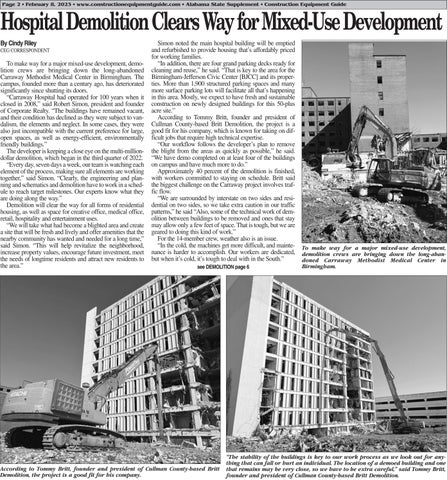Auburn University Program Looks to Revive, Build Resiliency

Across Alabama, the landscape is littered with abandoned shops, rusted-out factories and dilapidated homes without hope of revival in small towns that have seen better days. However, a program at Auburn University aims to reverse the state’s rural decline.
Rural Studio, a College of Architecture, Design and Construction program at the university, is an award-winning effort that uses architectural design to build resiliency in rural communities. It sits at the crossroads of theoretical academia and practical application.
According to the Alabama Department of Public Health, 55 of the state’s 67 counties are rural, and they hold almost 44 percent of the entire population. Compared to the



national average of 19 percent, Alabama is one of America’s most rural states.
Living in a rural community presents a breadth of challenges to residents, such as a lack of access to quality food, healthcare, broadband infrastructure and dependable housing.
Based in Newbern, a town of 221 residents, Rural Studio has become a member of the rural communities it was created over 30 years ago to support.
“I think I’ve learned more at Rural Studio than I have at any other studio within the architecture program,” Laurel Holloway, a recent graduate of the program, told The Auburn Plainsman, a student-run news source at the university.
Holloway is a member of a four-person
team that began the “Patriece’s Home” project in September, the fall semester of their last year at Auburn. The goal is to provide community members with a maintainable two-story house for them and their family.
The team designed the building’s concept, coordinated with the client and contractors, laid the foundation, and will drive the final nail.
Rural Studio builds all its projects following this model, according to the Plainsman.


“Normally, architecture students just draw stuff,” explained Andrew Freear, professor of architecture and director of Rural Studio. “They’re getting an incredible experience, learning how to put something together and manage a project, manage a budget and manage conversations with consultants.”
Students in the program also take support classes, like a history of wooden buildings, or they learn the hands-on skills necessary to complete a job, such as welding and carpentry.
“The students get remarkable hands-on opportunities out here that’s quite amazing,” Freear added. “I would have loved to have been out here as a student.”
The “Patriece’s Home” team of students will stay with the project until it is completed despite graduating next spring before their client can move in. Freear, though, told the Plainsman that it is common for students in the program to continue their work past graduation — so much so that they are lovingly called “leftovers.”
ALABAMA STATE EDITION A Supplement to: Your Alabama Connection • Rich Olivier, Atlanta, GA • 1- 800- 409 -1479 see AUBURN page 6
® “The Nation’s Best Read Construction Newspaper… Founded in 1957.” February 8 2023 Vol. XXV • No. 3 see STORY page 2 CALL 800-367-4937 *On approved credit Financing Available SHIP WITHIN 48 HOURS SAME DAY PARTS AVAILABILITY 24 HOUR TECHNICAL SUPPORT BACKED BY A 75 YEAR BUSINESS State Supplement sponsored by: Affordable Price. Premium Service. Thousands in Service!
Hospital Demolition Clears Way for Mixed-Use Development
By Cindy Riley CEG CORRESPONDENT
To make way for a major mixed-use development, demolition crews are bringing down the long-abandoned Carraway Methodist Medical Center in Birmingham. The campus, founded more than a century ago, has deteriorated significantly since shutting its doors.

“Carraway Hospital had operated for 100 years when it closed in 2008,” said Robert Simon, president and founder of Corporate Realty. “The buildings have remained vacant, and their condition has declined as they were subject to vandalism, the elements and neglect. In some cases, they were also just incompatible with the current preference for large, open spaces, as well as energy-efficient, environmentally friendly buildings.”
The developer is keeping a close eye on the multi-milliondollar demolition, which began in the third quarter of 2022.

“Every day, seven days a week, our team is watching each element of the process, making sure all elements are working together,” said Simon. “Clearly, the engineering and planning and schematics and demolition have to work in a schedule to reach target milestones. Our experts know what they are doing along the way.”
Demolition will clear the way for all forms of residential housing, as well as space for creative office, medical office, retail, hospitality and entertainment uses.

“We will take what had become a blighted area and create a site that will be fresh and lively and offer amenities that the nearby community has wanted and needed for a long time,” said Simon. “This will help revitalize the neighborhood, increase property values, encourage future investment, meet the needs of longtime residents and attract new residents to the area.”
Simon noted the main hospital building will be emptied and refurbished to provide housing that’s affordably priced for working families.
“In addition, there are four grand parking decks ready for cleaning and reuse,” he said. “That is key to the area for the Birmingham-Jefferson Civic Center [BJCC] and its properties. More than 1,900 structured parking spaces and many more surface parking lots will facilitate all that’s happening in this area. Mostly, we expect to have fresh and sustainable construction on newly designed buildings for this 50-plus acre site.”
According to Tommy Britt, founder and president of Cullman County-based Britt Demolition, the project is a good fit for his company, which is known for taking on difficult jobs that require high technical expertise.
“Our workflow follows the developer’s plan to remove the blight from the areas as quickly as possible,” he said. “We have demo completed on at least four of the buildings on campus and have much more to do.”
Approximately 40 percent of the demolition is finished, with workers committed to staying on schedule. Britt said the biggest challenge on the Carraway project involves traffic flow.
“We are surrounded by interstate on two sides and residential on two sides, so we take extra caution in our traffic patterns,” he said “Also, some of the technical work of demolition between buildings to be removed and ones that stay may allow only a few feet of space. That is tough, but we are geared to doing this kind of work.”
For the 14-member crew, weather also is an issue.
“In the cold, the machines get more difficult, and maintenance is harder to accomplish. Our workers are dedicated, but when it’s cold, it’s tough to deal with in the South.”
see DEMOLITION page 6
Page 2 • February 8, 2023 • www.constructionequipmentguide.com • Alabama State Supplement • Construction Equipment Guide
To make way for a major mixed-use development, demolition crews are bringing down the long-abandoned Carraway Methodist Medical Center in Birmingham.
According to Tommy Britt, founder and president of Cullman County-based Britt Demolition, the project is a good fit for his company.
“The stability of the buildings is key to our work process as we look out for anything that can fall or hurt an individual. The location of a demoed building and one that remains may be very close, so we have to be extra careful,” said Tommy Britt, founder and president of Cullman County-based Britt Demolition.
Connected to Customers, from Rock to Road®
We help build the roads that connect goods to markets, people to communities and families to one other. Astec pavers, screeds, mills, stabilizers and MTVs yield innovative and reliable Rock to Road solutions that create value and connection. We are inspired to connect with our customers through innovative design for safe and reliable roads. astecindustries.com

Construction Equipment Guide • Alabama State Supplement • www.constructionequipmentguide.com • February 8, 2023 • Page 3 COWIN.COM | 18002392694 Birmingham, AL 205.841.6666 Montgomery, AL 334.262.6642 Mobile, AL 251.633-4020 Oxford, AL 256.832.5053 Pensacola, FL 850.479.3004 Huntsville, AL 256.536.9390 Tuscaloosa, AL 205.848.4147 Atlanta, GA 404.696.7210
ROCK TO ROAD® Lawrenceville, GA COMING SOON



















































































































































































































































































Page 4 • February 8, 2023 • www.constructionequipmentguide.com • Alabama State Supplement • Construction Equipment Guide Construction Equipment Guide • Alabama State Supplement • www.constructionequipmentguide.com • February 8, 2023 • Page 5 02 Mini i Excavator tr spe l * eci A Main Inggredient
Britt Demolition Brings Down Former Hospital Buildings

DEMOLITION from page 2
As for the condition of the site, “The perimeter roadways were in good shape, our access has been good and the removal of scrap has been accessible,” said Britt, who stressed that safety is always the top concern. “The stability of the buildings is key to our work process as we look out for anything that can fall or hurt an individual. The location of a demoed building and one that remains may be very close, so we have to be extra careful.”
The area is clearly fenced to keep the public off the site, which is closely monitored.
“Our team watches each other to ensure our folks stay safe,” he said. “We carefully craft a plan for success in demolition, and are following that to ensure buildings are coming down as planned. We also have to watch for buried pipe and opportunities where the structure below grade can fail. This is why our experienced crews can perform effectively. They know how to do that, and do it well.”
Demolition is performed according to the developer’s desire for access.
“Buildings are numbered, and we are following their schematic to ensure proper delivery time,” said Britt, who added that debris is dealt with accordingly. “It is separated, and anything that can be crushed on site will be done. The rest goes to a landfill.”
Equipment on the project includes a 530 Doosan excavator with a 14, 000-lb. concrete breaker, a Hitachi 650 high reach, two 450 high reach machines, two 420 Doosan excavators equipped with grapple, a 350 Doosan excavator with magnetic grapple, a 350 Doosan excavator with concrete processor, two Doosan 350s with buckets with hydraulic dumps, a Cat concrete crusher, a Cat concrete screening plant and multiple Kenworth and Mack dump trucks.
As heavy machinery continues to dot the landscape, passersby can’t resist the urge to stop and get a closer look as the aging structures are reduced to rubble.
“Some of the neighbors have come around to watch and we welcome that, as we are proud of our work,” said Britt. “The site is on a busy street side, so the traffic gets to see our progress daily.”
While it will be some time before actual construction of the new development gets under way, Simon is confident it
will be successful.
“Timing has worked in our favor. The BJCC has recently built Protective Stadium, completed other renovations to its facilities and really revived the Uptown entertainment district. There have been other positive changes in the area, including the recent configurations of interstates, the creation of the City Walk Park and the location there by TopGolf. Our development rounds out this area with a lively live-workentertain element that will be outstanding.
“I’ve been in this business over 25 years, and this area has been in my view for that long. The north side of the city has beautiful, historic homes, winding streets, much like the Forest Park neighborhood. In addition, it provides a tremendous view into Jones Valley, where the City Center lies. For the past six years, we have been working to tie together parcels and plans to get to this point. Much of our work has been focused on engaging the nearby community and giving
Demolition will clear the way for all forms of residential housing, as well as space for creative office, medical office, retail, hospitality and entertainment uses.
them a voice in what this site will become.”
Nearby residents and motorists who regularly travel the area will be pleased to learn that Carraway’s iconic revolving emblem will continue to shine long after the buildings disappear.
“We anticipate the star atop the hospital will be used in graphics related to the development and hold a place on the site as a landmark. For many years, the community looked to that star, and we want to respect that history and preserve it for future generations.”
Said Simon, “The team at Corporate Realty and so many others in this community have been working to get to this point for a long time. This is a fine example of strong public-private partnership to address a blighted area and create a shared vision for the future. It’s very rewarding to see this vision come to life.”
(All photos courtesy of Britt Demolition.) CEG
Auburn Shines Light On Decline of Rural Life in Alabama
Program Participants Gain Perspective On Rural Life
Critically, Rural Studio does not observe its surroundings from an isolated place; rather, students and instructors have lived and worked in Newbern since Samuel Mockbee and D.K. Ruth co-founded the studio in 1993.
“I remember when I came here, there was a big amount of mistrust in academics,” Freear said. “[Academics] would come to this part of the world, they would do their research, get tenure, and then they [would] disappear again, and we [have not done that].”
Students and faculty also live in Newbern as a function of their studies and work.
“It’s really expected that you’ll be part of a community,” said Judith Seaman, a thirdyear instructor. “We get jobs in the area. We rent apartments in town. [This is] not a helicopter program. We’re rooted here. I worked at the library locally that we actually built about a decade ago.”
By embedding in the community, Rural Studio members gain perspective on rural living outside their degree program. For example, one of the persistent challenges of rural life is limited access to fresh foods due to limited access to supermarkets or grocery stores.
Despite its proximity to the agricultural
industry, Newbern is considered a food desert. However, reflecting the can-do attitude of their community, members of Rural Studio began growing vegetables in their front yard 13 years ago.
“My dean once said, ‘Why are we doing this? We’re architects, not farmers,’ and we basically [realized] this is out of necessity,” according to Freear. “We can drive 10 miles to get prepackaged processed foods, or we can start to grow it. So why not make it an educational thing?”
Each morning at 6:30 a.m., Rural Studio students start their day by helping to grow the 7,000 lbs. of food their community farm produces annually. Students and instructors
not only eat what they grow but share the bounty with surrounding communities.
While the farm does not solve the food desert crisis, it does help students understand the space around them, Freear noted, while also helping, in a small way, to protect a vital part of Southern tradition.
Despite the challenges rural communities face, their residents continue to come together to solve the problems they face, and Rural Studio is no exception, the Plainsman noted.
“People involved in agriculture and policy and community health, and all kinds of fields, can be involved in a similar way in their communities and work to affect it on a small scale that becomes kind of a larger system,” Seaman said.
Page 6 • February 8, 2023 • www.constructionequipmentguide.com • Alabama State Supplement • Construction Equipment Guide
AUBURN from page 1


Construction Equipment Guide • Alabama State Supplement • www.constructionequipmentguide.com • February 8, 2023 • Page 7

Page 8 • February 8, 2023 • www.constructionequipmentguide.com • Alabama State Supplement • Construction Equipment Guide






















































































































